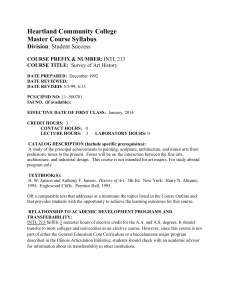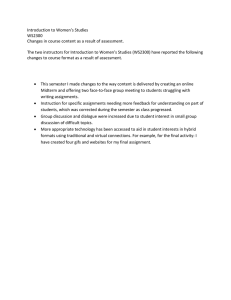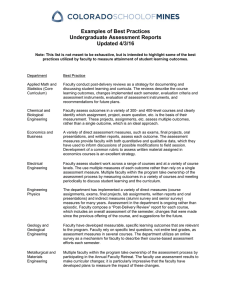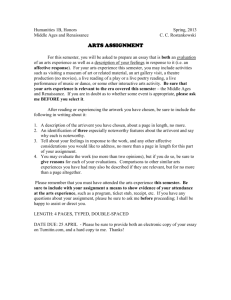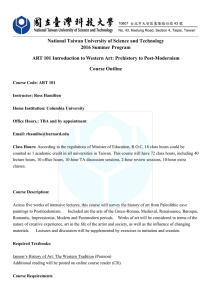ARTH 308: Renaissance Tradition in Art TTH 4:00-5:15 Room A20
advertisement
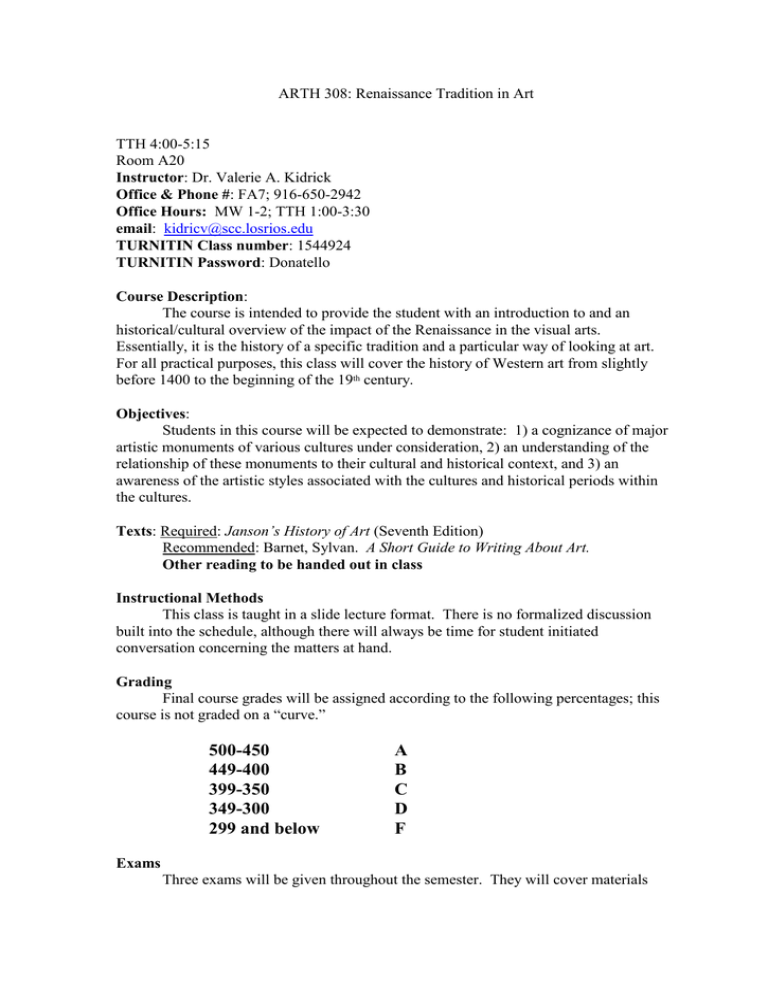
ARTH 308: Renaissance Tradition in Art TTH 4:00-5:15 Room A20 Instructor: Dr. Valerie A. Kidrick Office & Phone #: FA7; 916-650-2942 Office Hours: MW 1-2; TTH 1:00-3:30 email: kidricv@scc.losrios.edu TURNITIN Class number: 1544924 TURNITIN Password: Donatello Course Description: The course is intended to provide the student with an introduction to and an historical/cultural overview of the impact of the Renaissance in the visual arts. Essentially, it is the history of a specific tradition and a particular way of looking at art. For all practical purposes, this class will cover the history of Western art from slightly before 1400 to the beginning of the 19th century. Objectives: Students in this course will be expected to demonstrate: 1) a cognizance of major artistic monuments of various cultures under consideration, 2) an understanding of the relationship of these monuments to their cultural and historical context, and 3) an awareness of the artistic styles associated with the cultures and historical periods within the cultures. Texts: Required: Janson’s History of Art (Seventh Edition) Recommended: Barnet, Sylvan. A Short Guide to Writing About Art. Other reading to be handed out in class Instructional Methods This class is taught in a slide lecture format. There is no formalized discussion built into the schedule, although there will always be time for student initiated conversation concerning the matters at hand. Grading Final course grades will be assigned according to the following percentages; this course is not graded on a “curve.” 500-450 449-400 399-350 349-300 299 and below A B C D F Exams Three exams will be given throughout the semester. They will cover materials presented in class and material from your textbook. Do not rely on only the textual information as you are studying. I will provide materials NOT in your texts, and, conversely, will not cover everything that is in the text in class lectures. The exams can be a combination of slide identification, essay, compare and contrast, or short answer. No make up exams are given. The lowest exam grade is automatically dropped. Research/Writing assignments Four small (two page) assignments will be required throughout the semester. More information about these assignments will be given throughout the semester. All assignments will be turned in through TURNITIN.com. I will not accept any paper handed to me in paper format. More information on the assignments and the requirements for turning them will be given out during the semester. PROFESSIONIALISM IN THE CLASSROOM I expect everyone to behave in a manner that encourages education. I believe that there are a number of components to that. They include: COME TO CLASS This class is about visual culture; therefore much of what you will need to know to pass the class is available primarily in class and through the lectures. Therefore, attendance is required. Students who accumulate more than four (4) unexcused absences may find their grade adversely affected DO NOT BE LATE What would happen to you if you regularly showed up late to your job? You’d be fired. So don’t be surprised when you get a bad grade because you can’t make it to class on time. TURN THINGS IN ON TIME It is YOUR responsibility to make it here when you are supposed to be here, with the items you are supposed to have with you. I DO NOT ACCEPT LATE ASSIGNMENTS. I DO NOT GIVE LATE EXAMS. I WILL NOT GO BACK OVER SLIDES YOU HAVE MISSED. You may turn written work in early through TURNITIN. If it is date and time stamped after the time class begins on the day the work is due, you WILL NOT receive credit for the work. Do not ask me to make an exception for you, because I will not. DO NOT PLAGIARIZE A pet peeve of mine. Plagiarism occurs whenever you use someone else’s ideas or words as your own, whether in writing or speaking. IT IS NOT JUST “COPYING” WORD FOR WORD!!!!. Let me elaborate: If you copy materials from any source, published or unpublished, and do not properly cite your source, that is plagiarism. If you use ideas from a source or paraphrase it closely without acknowledgement, that is plagiarism. If you present another student’s paper or other work as your own, that is plagiarism. If you get so much help that the result is quite different from your own work, that is plagiarism. As you can see, the term covers much more than simple copying of someone else’s written material. Suffice it to say, not only do I know it's the worst thing a student can do, so does the College. Anyone who is caught cheating or plagiarizing on a test or a paper will not be allowed to do the assignment over, will be given an “F” on that assignment, and will be referred to the appropriate college official. DON’T RUN THE RISK. CHALLENGE ASSUMPTIONS This course is about art, and art is usually a subjective thing. I happen to believe that it is exceedingly rare to find only one “right” answer to the questions that get posed by humans; most of the time there are multiple “right” answers--generally as many right answers as there are opinions. Therefore, I expect that not everyone will agree with me all the time. Actually, I’d prefer it if we all didn’t agree all the time--this lets me know you are critically thinking about what I’m saying. Please feel free to question and pose queries (in a nice manner, please) at anytime. Of course, this shouldn’t be taken to mean that ANY answer you give on a test will be marked as correct (alas, such is the way of College)--more that I expect you to gather all the pertinent information, assess the facts critically, and make a case for your conclusions. SHOW RESPECT TO YOURSELF, YOUR COLLEAGUES, AND ME Harassment of any kind will not be tolerated in this classroom. If you feel you are being harassed in any way, please inform me. I expect everyone in my classes to be respectful of each other, while encouraging diversity in beliefs and opinions. OPTIMIZE YOUR EDUCATION I am always willing to talk to you about your performance in this class, and help you in any way that I am able. Take advantage of the help I might be able to give you, both in this class and perhaps in others. This does not mean I will write your papers, tell you what the answers are, or do anything else that could be misconstrued as “cheating”. It does mean, however, that your tuition also pays for some of my time outside of class, and if you have questions or concerns, I’d like to hear them. Additionally, students with documented disabilities needing accommodations such as testing, interpreting, note taking, taped textbooks, assistive technology, equipment, accessibility arrangements, etc., must contact me as soon as possible after the beginning of the semester. Please let me know of any difficulties you may have, so that we can make arrangements for you. If you have ANY QUESTIONS, PROBLEMS ,OR CONCERNS about the class: Please see me soon after the semester(or the problem) begins. I can’t help if I don’t know what the problem is. Dr. Kidrick ARTH 308: The Renaissance Tradition in Art Fall 2006 Course Schedule Week 1 Discussion of course requirements, goals, etc. 13th/14th Century Italy Janson: Chapter 13, p. 437-467 Weeks 2-3 15th Century Northern European Art Janson: 469-501 Weeks 4-5 Early Renaissance in 15th Century Italy Janson: 503-553 EXAM # 1: September 26th (pp. 437-553 plus any handouts) Weeks 6-7 The High Renaissance in Italy, 1495-1520 Janson: 555-585; Harbison Handout Week 8 The Late Renaissance and Mannerism in 16th century Italy Janson: 587-619 Week 9-10 Renaissance and Reformation in 16th century Northern Europe Janson: 621-657 EXAM # 2 October 31st (pp. 555-657 plus any handouts) Week 11-12 The Baroque in Italy and Spain Janson: 659-695 Week 13 The Baroque in the Netherlands Janson: 697-731 Week 14-15 The Baroque in France and England Janson: 733-755 Week 16-17 The Rococo Janson: 757-787 Final Exam: December 21st, 3:10-5:10 (pp. 648-77 plus any handouts)
